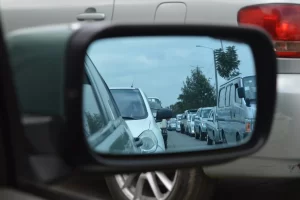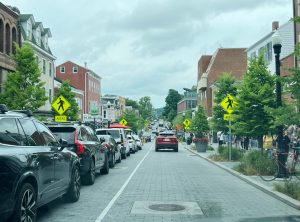 In March, the Princeton community was shaken when a 74-year-old pedestrian was struck by a driver while walking along Wiggins Street near Sylvia Beach Way. More than 430 people were killed in the Delaware Valley region using the roadway system in 2023. This number contributes to the 1.19 million people killed in crashes worldwide that same year. Local officials and transportation experts are working to change those statistics by embracing the concept of Vision Zero. Developed in Sweden in the 1990s, Vision Zero is an approach to road safety based on the principle that no loss of life is acceptable. Since then, Vision Zero has spread internationally and officially arrived in the United States in 2014 when New York City’s Vision Zero effort was launched. Philadelphia launched their effort in 2017 and currently several New Jersey entities have also embraced Vision Zero including Mercer County and Princeton.
In March, the Princeton community was shaken when a 74-year-old pedestrian was struck by a driver while walking along Wiggins Street near Sylvia Beach Way. More than 430 people were killed in the Delaware Valley region using the roadway system in 2023. This number contributes to the 1.19 million people killed in crashes worldwide that same year. Local officials and transportation experts are working to change those statistics by embracing the concept of Vision Zero. Developed in Sweden in the 1990s, Vision Zero is an approach to road safety based on the principle that no loss of life is acceptable. Since then, Vision Zero has spread internationally and officially arrived in the United States in 2014 when New York City’s Vision Zero effort was launched. Philadelphia launched their effort in 2017 and currently several New Jersey entities have also embraced Vision Zero including Mercer County and Princeton.
The Delaware Valley Regional Planning Commission (DVRPC), the metropolitan planning organization for Greater Philadelphia, is developing a Regional Vision Zero (RVZ) plan in collaboration with nine counties in the region, including Mercer County. With funding from a Safe Streets and Roads for All (SS4A) grant, planners are working on a plan that is data-driven and collaborative, using the Federal Highway Administration’s Safe System Approach (SAA) framework. The resulting products and tools will help government agencies identify and prioritize infrastructure improvements.
As part of the Regional Vision Zero effort, DVRPC released the Regional High Injury Network. This mapping tool identifies the most dangerous roadways, where there are higher concentrations of fatalities and serious injury crashes. There is also a bicyclist and pedestrian crash layer to help identify where vulnerable road users are particularly exposed. DVRPC has also launched a Regional Vision Zero Traffic Safety Concerns crowdsource map where the public can identify unsafe locations. Information gathered will be shared with county and municipal partners and will inform the Regional Vision Zero plan. The tool will be live until May 16th.
What’s happening in Mercer County?
 Mercer County has partnered with the Greater Mercer Transportation Management Association (GMTMA) to create a Vision Zero Action Plan as part of DVRPC’s Regional Vision Zero program. GMTMA recently completed a public outreach survey for the Mercer County Vision Zero Action plan. More than 1600 responses were received over two months, with 94% of respondents living in the County and 6% either working in or visiting the county regularly.
Mercer County has partnered with the Greater Mercer Transportation Management Association (GMTMA) to create a Vision Zero Action Plan as part of DVRPC’s Regional Vision Zero program. GMTMA recently completed a public outreach survey for the Mercer County Vision Zero Action plan. More than 1600 responses were received over two months, with 94% of respondents living in the County and 6% either working in or visiting the county regularly.
When asked how they currently travel within Mercer County, 95% of survey respondents indicated they use a personal vehicle most of the time, while 42% say they walk frequently or very frequently. Biking and transit have similar results, about half said they never do either, and about 45% said they will rarely or sometimes. 13% will bike frequently or very frequently, but only 6% will use transit the same amount.
Even though 80% of respondents felt that driving a personal vehicle was desirable or very desirable when asked how they would like to get around Mercer County in the future, it is 15% lower than how frequently respondents are currently using a personal vehicle. The most desirable modes after personal vehicles were walking and biking, where 70% think walking is desirable and 55% feel biking is, which means 28% of respondents would like to walk more, and 42% would prefer to bike more.
 Safety is a concern and a barrier to walking and biking for many people in the county. When asked how safe they feel when using different types of transportation in Mercer County, nearly half of respondents felt unsafe or very unsafe while walking or biking. Only 8% of respondents felt safe or very safe while biking, and 28% felt safe or very safe while walking.
Safety is a concern and a barrier to walking and biking for many people in the county. When asked how safe they feel when using different types of transportation in Mercer County, nearly half of respondents felt unsafe or very unsafe while walking or biking. Only 8% of respondents felt safe or very safe while biking, and 28% felt safe or very safe while walking.
A majority (80%) of survey respondents feel that zero is the only acceptable number of people killed or seriously injured on our roadways each year, while 19% gave a response between 1-100, and less than 1% responded between 500-4000 people. Respondents who gave an answer other than zero were reminded that every person killed was someone’s friend or family member. When again asked if the goal should be zero deaths and serious injuries for everyone, 95% said yes.
Mercer County is waiting for final contract approval of an SS4A supplemental planning grant, awarded in 2024, to extend the reach of DVRPC’s regional effort. The goal is a deep dive into roadway data to identify locations where the county and our towns can install some of the Federal Highway Administration’s (FHWA) Proven Safety Countermeasures, such as roundabouts and protected facilities for people not traveling in cars. A recent announcement of a new round of implementation grants available to local agencies confirms that FHWA is continuing its commitment to safety for all road users.
In Mercer County, support for Vision Zero also comes from the healthcare community through the Greater Mercer Public Health Partnership (GMPHP), a collaboration of three hospitals, eight health departments, Mercer County Human Services, and 70 not-for-profit organizations whose mission is to measurably improve community health. GMPHP passed a Vision Zero resolution several years ago, and its recently updated Community Health Improvement Plan (CHIP) includes Vision Zero as a strategy in the CHIP’s goal to improve community health.
What’s happening in Princeton?
 Since 2019, the Municipality of Princeton has supported Vision Zero and formalized that support with a resolution in 2022. Vision Zero guides the improvement of Princeton’s streets and transportation systems to prioritize safety. Vision Zero informed the creation of the Mobility Element in Princeton’s Master Plan, which outlines a street design hierarchy valuing walking, biking, transit, and other modes of transportation over single occupancy vehicles. The Witherspoon Street improvements exemplify the Vision Zero principles with the reduced vehicle speed limit, narrowed travel lanes, raised crosswalks, curb extensions for shorter crosswalk distances, and replanting of the roadside tree canopy. With every project, Princeton’s Department of Infrastructure and Operations reviews applicable crash data and looks at FHWA’s Proven Safety Countermeasures to implement roadway improvements.
Since 2019, the Municipality of Princeton has supported Vision Zero and formalized that support with a resolution in 2022. Vision Zero guides the improvement of Princeton’s streets and transportation systems to prioritize safety. Vision Zero informed the creation of the Mobility Element in Princeton’s Master Plan, which outlines a street design hierarchy valuing walking, biking, transit, and other modes of transportation over single occupancy vehicles. The Witherspoon Street improvements exemplify the Vision Zero principles with the reduced vehicle speed limit, narrowed travel lanes, raised crosswalks, curb extensions for shorter crosswalk distances, and replanting of the roadside tree canopy. With every project, Princeton’s Department of Infrastructure and Operations reviews applicable crash data and looks at FHWA’s Proven Safety Countermeasures to implement roadway improvements.
Get involved!
Crash safety planning has always been a focus of DVRPC’s work, and in 2005 the Regional Safety Task Force was launched. Through quarterly meetings the task force promotes effective partnerships among private and public sectors with content featuring practitioners who are working to eliminate crash fatalities and serious injuries. We are working hard together to ensure that no one else has to suffer from a preventable roadway tragedy again.
To stay in touch with all Regional Vision Zero activity, register for DVRPC’s Vision Zero email list.
 Kevin Murphy is Manager, Office of Safe Streets, Delaware Valley Regional Planning Commission (DVRPC). In over 26 years with DVRPC, Kevin has become a seasoned team leader guiding safety-focused planning studies, road safety audits, and providing support to partners in advancing safety recommendations. He facilitated the adoption of Regional Vision Zero 2050 and its integration into DVRPC’s work, the setting of regional safety targets, and is currently leading the development of the Regional Vision Zero plan. He possesses a comprehensive knowledge of transportation safety planning and is a thoughtful collaborator in diagnosing problems and building consensus to advance safe and equitable access for all system users.
Kevin Murphy is Manager, Office of Safe Streets, Delaware Valley Regional Planning Commission (DVRPC). In over 26 years with DVRPC, Kevin has become a seasoned team leader guiding safety-focused planning studies, road safety audits, and providing support to partners in advancing safety recommendations. He facilitated the adoption of Regional Vision Zero 2050 and its integration into DVRPC’s work, the setting of regional safety targets, and is currently leading the development of the Regional Vision Zero plan. He possesses a comprehensive knowledge of transportation safety planning and is a thoughtful collaborator in diagnosing problems and building consensus to advance safe and equitable access for all system users.
 Matthew P. Lawson, Ph.D., AICP, PP is Principal Planner-Transportation, County of Mercer, New Jersey where he has served as transportation planner for Mercer County since 2004. His responsibilities have included updating the County Master Plan Mobility Element to include complete streets and access management policies, leading County implementation of a highway asset management system, facilitating transportation funding and planning projects, including planning for transit oriented land development, trails, highway safety, bicycle, and transit improvements. Lawson previously taught sociology at The College of New Jersey, Brandeis University, and Williams College.
Matthew P. Lawson, Ph.D., AICP, PP is Principal Planner-Transportation, County of Mercer, New Jersey where he has served as transportation planner for Mercer County since 2004. His responsibilities have included updating the County Master Plan Mobility Element to include complete streets and access management policies, leading County implementation of a highway asset management system, facilitating transportation funding and planning projects, including planning for transit oriented land development, trails, highway safety, bicycle, and transit improvements. Lawson previously taught sociology at The College of New Jersey, Brandeis University, and Williams College.
 Chris Townley is Transportation Planning Specialist with Greater Mercer Transportation Management Association. Townley is a transportation planner who believes everyone should have the safe choice to travel without a car. At the Greater Mercer TMA, Chris is part of the team working on the Mercer County Vision Zero Action Plan and many other projects to make walking, biking, and transit safer and more accessible.
Chris Townley is Transportation Planning Specialist with Greater Mercer Transportation Management Association. Townley is a transportation planner who believes everyone should have the safe choice to travel without a car. At the Greater Mercer TMA, Chris is part of the team working on the Mercer County Vision Zero Action Plan and many other projects to make walking, biking, and transit safer and more accessible.
